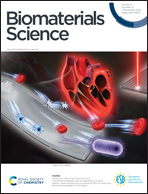NIR/photoacoustic imaging of multitype gallbladder cancer using carboxyl/amino functionalized polymer dots†
Abstract
Gallbladder cancer has high incidence and mortality and a low early diagnosis rate and requires rapid and efficient diagnosis. Herein, carboxyl/amino functionalized polymer dots (Pdots) were designed to enhance cellular internalization and tumor accumulation. The prepared Pdots were 40–50 nm in diameter, contained no toxic metal, exhibited long circulation time and high stability, and produced strong NIR emission and photoacoustic signals. Different cellular uptake and distribution of functionalized Pdots in eight gallbladder cell lines were quantitatively investigated using flow cytometry and super-resolution microscopy. In vivo NIR fluorescence imaging showed that the functional Pdots had high accumulation in the tumor after 30 minutes of injection and remained there for up to 6 days. In addition, photoacoustic imaging found that the abundant blood vessels around the tumor microenvironment and Pdots entered the tumor through the blood vessels. Furthermore, a high heterogeneity of vascular networks was visualized in real-time and high resolution by probe-based confocal laser endomicroscopy imaging. These results offer a new avenue for the development of functional Pdots as a probe for multi-modal and multi-scale imaging of gallbladder cancer in small animals.



 Please wait while we load your content...
Please wait while we load your content...